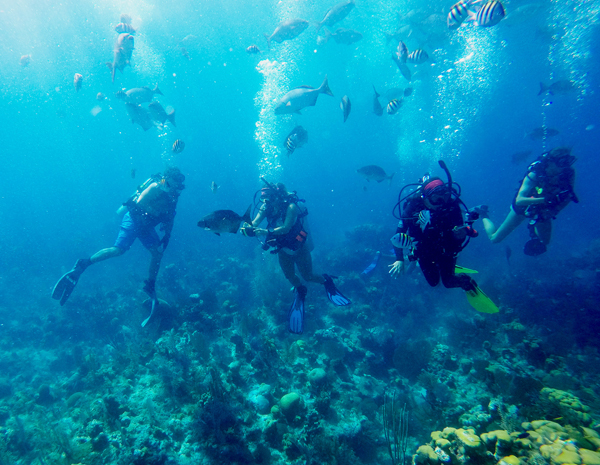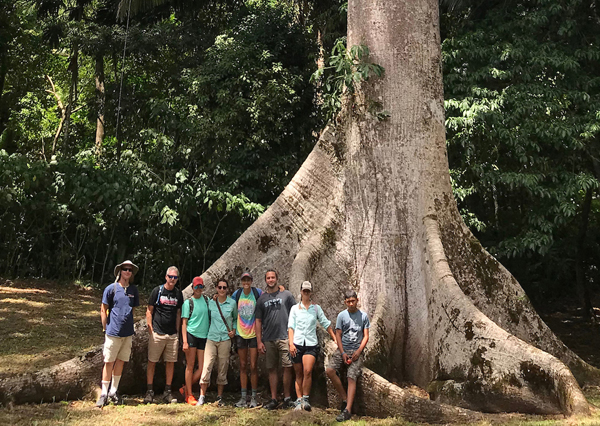- La Feria Community Holds Succesful Business Mixer Event
- Little Nashville to Take Place in Downtown Mercedes
- Lions Basketball Captures District Gold
- La Feria ISD Students Compete in Regional Chess Tournament
- Lions End First Half of 32-4A on a High Note
- La Feria ISD Held Another Successful Parent Conference
- Strong Appearance for Lions at Hidalgo Power Meet
- LFECHS Students Get to Meet Local Actress
- Students Participate in Marine Biology Camp
- Two LFECHS Students Qualify for All-State Band
Students Dive into Their Research in Belize
- Updated: September 28, 2018
by Maria Elena Hernandez
RIO GRANDE VALLEY, TEXAS – UTRGV students studying abroad in Belize this summer explored one of the most famous dive sites in the world – the Great Blue Hole.
“You dive down and it’s just open blue, just beautiful,” said Chelsea Pavliska, a UTRGV graduate student from Liberty Hill, Texas.
The Ocean, Coastal and Earth Sciences major was one of the students enrolled in the coral reef ecology course in Belize, led by Dr. David Hicks, director of the UTRGV School of Earth, Environmental and Marine Sciences.
“I don’t know very many places where you get to go diving for your research or diving for a class, like at UTRGV,” Pavliska said.
The Great Blue Hole is part of the Mesoamerican Barrier Reef, the largest coral barrier reef in the Western Hemisphere.
“A major portion of it runs across the country of Belize, so that’s why we went to that country in particular,” said James Stilley, a UTRGV graduate student from Covina, California, majoring in Agricultural, Environmental and Sustainability Sciences.
“You hear about the Mesoamerican Reef, but until you really get to the reef and see the drop-offs and see the different zones – it’s hard to really picture it just from reading a textbook.”
Students used data collected during the dives for their individual research projects.
“We would have a short class in the morning. And then we would got out and do work for our research,” Pavliska said. “My research project was on octocorals. I go out and sample, doing either scuba diving or using ROV (remotely operated vehicles), so this class really aligned well with what I’m doing with my thesis.”
Stilley studied the revival of an urchin population that was almost wiped out a few decades ago.
“What I found out coming back and writing the paper was that a new urchin has kind of taken over the place of the longspine urchin, which is Echinometra virdis – the reef urchin. And it might become the new dominant urchin,” he said.

UTRGV students studying abroad in Belize this summer explored one of the most famous dive sites in the world – the Great Blue Hole, part of the Mesoamerican Barrier Reef, which is the largest coral barrier reef in the Western Hemisphere – during the Ocean, Coastal and Earth Sciences course on coral reef ecology. Students used data collected during the dives for their individual research projects. The course, led by Dr. David Hicks, director of the UTRGV School of Earth, Environmental and Marine Sciences, also took them to a tropical education center in the rain forest. (Courtesy Photos)
The group’s time in Belize wasn’t limited to the barrier reef. They also stayed at a tropical education center in the jungle and adjacent to a zoo.
“I wanted to see the rain forests just as much as the reefs, and I was blown away by both,” Stilley said.
While at the education center, he learned researchers there are working on a project of special interest to him.
“It’s been a long-time dream of mine to help design and research wildlife corridors, especially for small cats and mesocarnivores,” he said.
Researchers at the center are working on similar corridor plans in Belize.
“It’s kind of cool to see a reserve looking into building a corridor for that, and what parameters they’re using,” he said. “All that kind of brings it full circle, realizing that what you learn here is just as applicable abroad.”
For more information on UTRGV study abroad programs, visit https://www.utrgv.edu/ipp/study-abroad/index.htm.
UTRGV STUDENTS – STUDY ABROAD:
- Catherine Eckert, graduate student, biology, Austin, Texas.
- Chelsea Pavliska, graduate student, Ocean, Coastal and Earth Sciences, Liberty Hill, Texas.
- Ivy Hinson, graduate student, Ocean, Coastal and Earth Sciences, Chadbourn, North Carolina.
- Stefany Salinas, graduate student, Ocean, Coastal and Earth Sciences, Brownsville.
- James Stilley, graduate student, Agricultural, Environmental and Sustainability Science, Covina, California.




